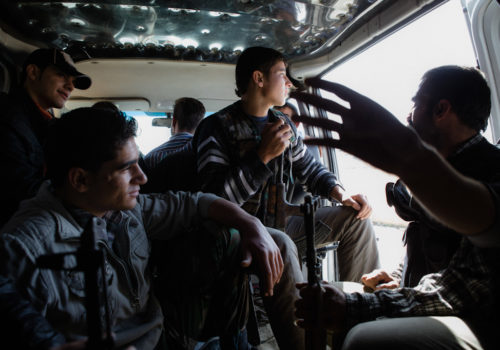Australian photojournalist Ed Giles is based in Cairo, and has returned home to Sydney as the technical editor for Reportage’s projections programme. Giles, who is represented by Getty Images, has extensively covered the Arab Spring and the work he has on show at Reportage includes recent images shot in Aleppo, Syria.
In November last year Giles travelled with a unit of the Free Syrian Army in Aleppo, with the intention of telling a more “human story, which ended up being in the context of the katiba, an army unit,” he explained.
Of his visit to a city that is fraught with danger for international journalists and photographers, Giles said luck played a big part in the success of his tour. “I travelled and worked with a very good Egyptian friend of mine who is an activist and video journalist in Cairo. He worked with me as my translator, and he was doing his own work too. In that environment it was incredibly fortunate to work with someone I know very well and trust, as often in these situations I could have ended up with a random Syrian person working as a fixer, someone who speaks English, but whom I didn’t know”.
Luck held with them from the start as the pair made their way into Syria through Turkey via a “relatively safe route with good people”. Then finding a katiba that was active, “doing interesting things and happy to talk on camera” delivered another lucky break. “I’ve had friends go in with a unit and sit in an apartment for days without going out, and without getting them on camera. So I got really lucky and nothing really awful happened while I was there in the immediate vicinity so it wasn’t a particularly bad experience in terms of the level of risk”.
The photo essay Giles shot in Aleppo forms part of his greater body of work on the Arab Spring conflicts. Capturing the images in “On the Front Line with Aleppo’s Martyrs of Truth” involved going out on night patrol, climbing through hollowed out buildings to avoid being on the street and exposed to snipers, and living with the katiba in the apartments appropriated by the Free Syrian Army for their bases.
The katiba Giles worked with was based in “a very nice upper middle class area of Aleppo”, where there had been beautiful parks and apartments full of memories of lives well lived. We talk about a photograph where the leader of the katiba, who was killed only days after Giles left the city, is praying. In the apartment are photographs of children and the personal belongings of those who have fled. It is a stark reminder of the toll of the conflict on the citizens of the city whose lives have been upturned.
Giles said it was an odd experience to camp in someone’s home, and clearly that sentiment was also held by members of the katiba. “As you move through these apartment buildings with the katiba there’s all sorts of graffiti on the walls of the stairwells. Some are messages to the people who own the apartments saying the Free Syrian Army didn’t do this to your house, we are sorry to damage your property, but we have to in order to save Syria. They know they are occupying peoples homes”.
The Free Syrian Army comprises many who have defected from the government’s troops and there were a few in the katiba Giles travelled with that were uncertain of Giles’ objectives and reluctant to go on camera. “But the three guys at the top of the katiba wanted us there to tell their story so the standing order was to welcome us”. As a result Giles has captured a series of images that allow the viewer to see the human side to these fighters who lie hidden in an ancient city which has seen it all before.
Reportage Projections – check the website for locations
Alison Stieven-Taylor
















